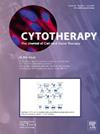Standardizing MSC Therapies: A Framework for Addressing Donor Variability and Benchmarking Functional Heterogeneity
IF 3.7
3区 医学
Q2 BIOTECHNOLOGY & APPLIED MICROBIOLOGY
引用次数: 0
Abstract
Background & Aim
Inter- and intra-donor variability poses a significant challenge to ensuring consistent quality and performance in cell therapies. This challenge is emphasized in MSC therapies, which rely on the cells' inherent, multifaceted therapeutic capacities. Compared to cells with defined therapeutic targets, MSC efficacy is more sensitive to donor and batch variations, complicating standardization. MSC priming has emerged as a strategy to enhance therapeutic potency and consistency. Previously, we introduced a primed MSC therapy (MesenCure™) that reduced mortality by 68% and the need for invasive ventilation by 57% in respiratory distress patients. Here, we characterize the distinct phenotype of primed MSCs and introduce a framework for assessing functional heterogeneity, enabling the evaluation of cell bank performance against established benchmarks.
Results & Conclusion
Results: RNAseq analysis of primed MSCs from 3 donors revealed 6,909 differentially expressed genes (Fig. 1A, q<0.01) compared to unprimed MSCs. PCA of genes accounting for 99.9% of variability demonstrated distinct clustering of donors by priming status (Fig. 1B). Similar patterns were observed in PCA of cellular and secretome proteomic data from 3 batches derived from a single donor (Figs. 1C, 1D), reaffirming the unique phenotype of primed MSCs.
Subsequently, donor variability was assessed in 15 donor-derived primed cell batches, examining parameters related to immunomodulatory capacity (IC50 of CD4+ T-cell activation), regenerative potential (FGF7 secretion), and cellular durability (autophagy levels) (Fig. 2A). PCA of these parameters identified a principal component (PC1) linked to enhanced performance, clustering batches into low-, medium-, and high-performing groups (Fig. 2B).
To evaluate our clinical cell bank performance, we simulated 1,000 normally distributed samples (Fig. 2C) based on observed averages for IC50 (N = 67), FGF7 (N = 16), and autophagy (N = 4), overlaid in Fig. 2A. PC1 values for the simulated samples, calculated using the same transformation that identified the three clusters, were overlaid onto these clusters in Fig. 2B. The distribution of simulated PC1 values demonstrated alignment of clinical cell bank batches with the high-performing cluster (Figs. 2B, 2D).
Conclusion
In conclusion, these findings present a robust blueprint for assessing functional heterogeneity among MSC batches, offering a practical framework to benchmark cell bank performance and advance the standardization of MSC-based therapies
标准化间充质干细胞治疗:解决供体变异和基准功能异质性的框架
背景,供体间和供体内的差异对确保细胞治疗的一致质量和性能构成了重大挑战。这一挑战在MSC疗法中得到了强调,MSC疗法依赖于细胞固有的、多方面的治疗能力。与具有明确治疗靶点的细胞相比,间充质干细胞的疗效对供体和批次的变化更为敏感,这使标准化变得复杂。MSC启动已成为提高治疗效力和一致性的策略。此前,我们引入了一种启动MSC治疗(MesenCure™),可将呼吸窘迫患者的死亡率降低68%,有创通气需求降低57%。在这里,我们描述了引物间充质干细胞的不同表型,并引入了评估功能异质性的框架,从而能够根据既定基准评估细胞库的性能。结果,结果:对来自3个供体的引物MSCs进行RNAseq分析,发现与未引物MSCs相比,6909个差异表达基因(图1A, q<0.01)。占变异率99.9%的基因PCA显示,通过启动状态,供体明显聚类(图1B)。从单个供体提取的3批细胞和分泌组蛋白组学数据的PCA中观察到类似的模式(图1C, 1D),重申了引物MSCs的独特表型。随后,在15个供体衍生的启动细胞批次中评估供体变异,检查与免疫调节能力(CD4+ t细胞激活的IC50)、再生潜力(FGF7分泌)和细胞耐久性(自噬水平)相关的参数(图2A)。这些参数的PCA确定了与增强性能相关的主成分(PC1),将批次聚类为低、中、高性能组(图2B)。为了评估我们的临床细胞库性能,我们基于观察到的IC50 (N = 67)、FGF7 (N = 16)和自噬(N = 4)的平均值模拟了1000个正态分布样本(图2C),叠加在图2A中。模拟样本的PC1值,使用识别三个簇的相同变换计算,在图2B中覆盖到这些簇上。模拟PC1值的分布表明临床细胞库批次与高性能集群一致(图2B, 2D)。总之,这些发现为评估MSC批次之间的功能异质性提供了一个强有力的蓝图,为基准细胞库性能提供了一个实用的框架,并推进了基于MSC的治疗的标准化
本文章由计算机程序翻译,如有差异,请以英文原文为准。
求助全文
约1分钟内获得全文
求助全文
来源期刊

Cytotherapy
医学-生物工程与应用微生物
CiteScore
6.30
自引率
4.40%
发文量
683
审稿时长
49 days
期刊介绍:
The journal brings readers the latest developments in the fast moving field of cellular therapy in man. This includes cell therapy for cancer, immune disorders, inherited diseases, tissue repair and regenerative medicine. The journal covers the science, translational development and treatment with variety of cell types including hematopoietic stem cells, immune cells (dendritic cells, NK, cells, T cells, antigen presenting cells) mesenchymal stromal cells, adipose cells, nerve, muscle, vascular and endothelial cells, and induced pluripotential stem cells. We also welcome manuscripts on subcellular derivatives such as exosomes. A specific focus is on translational research that brings cell therapy to the clinic. Cytotherapy publishes original papers, reviews, position papers editorials, commentaries and letters to the editor. We welcome "Protocols in Cytotherapy" bringing standard operating procedure for production specific cell types for clinical use within the reach of the readership.
 求助内容:
求助内容: 应助结果提醒方式:
应助结果提醒方式:


